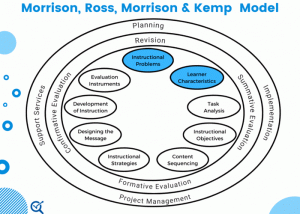3 Learning & Contextual Analysis
Front-End Analysis: Learner & Contextual Analysis

Learner and Contextual Analysis is a basic component of the analysis step in any ID model. You must know who your target audience (TA) is and the likely environmental factors that will influence learning. Typically, the more you know about your learners, the more likely you will be able to tailor the instruction to suit their needs and design instruction more relevant to the learners.
As you may have guessed by reading the information above, we are moving to the Learner Characteristics section of our model and project. By understanding who your learners are, the learning environment, and the context in which content will be used outside the classroom, you can make design decisions that better align with learner needs. For example, I remember teaching Computer Science courses for a private college in the mid 90s. This was when computers were really taking off and the Internet was born. Half way through the quarter, I realized that about 85% of my students were failing. This was devastating. At first, I wanted to blame the students for not working hard enough. However, I decided to pause, talk to my students, interview our registration and advising staff, and review my curriculum. Here’s what I learned…
- My Computer Science course is very hands-on and requires a computer for completing assignments.
- Class was conducted in a computer lab.
- Class time was used to demonstrate skills while grades were based on homework that required a computer.
- Students were smart and going to school to change fields and get better jobs.
- Most students were working, single parents without computers at home.
- A basic computer cost between $3,000 and $5,000.
- A majority of the students were utilizing Financial Aid and unable to afford a computer.
- Our school had a cohort structure with back-to-back classes from 8:00 a.m. until 2:00 p.m.
- The only time students had to use our onsite computer lab was after classes.
- Due to cost of childcare, students needed to get home to meet their kids after school or get to work.
Based on my findings, I flipped my classroom so that all homework requiring a computer was completed during class time and with me there to support. By doing this, there was an immediate change in the number of students passing my course. By knowing my students, the challenges they face, and the skills and experiences they bring to class, I am able to make design decisions that help them succeed.
In the same vein, by knowing your environment, you are also able to make better design decision. For example, if I were teaching that same computer science course in a lecture hall where students didn’t have a computer on their desk, I would look to change classrooms if possible.
In this module, you will conduct your own Learner Analysis and reflect on how the information you discover will impact your design decisions.
Learning Styles
Your textbook does point out that not all learner characteristics will or should affect the design of instruction. For example, would a learner’s preference for learning by doing (kinesthetic learning) affect how you teach a class a set of definitions? If you had a class full of all kinesthetic learners, then probably it would affect how you design the activity. However, you are more likely to have a mixed group of auditory learners, visual learners, and kinesthetic learners which would make tailoring the instruction to their preferred learning style a difficult task.
Whether it is important to address learning styles is still controversial in the ID field. Those who argue that learning styles are important often link learning styles to the multiple intelligences theory by Howard Gardner, as they do at this website, Overview of learning styles. Hear Howard Gardner explain the 8 Intelligences in the first video below.
So, how do we use this information in our instructional design? The second video talks about putting learning styles and intelligences to work in the classroom by providing strategies for each. As you watch, think about the importance of variety and choice in your design? Can you see any of these strategies being used in this course? Which of those strategies align with the way you learn?
